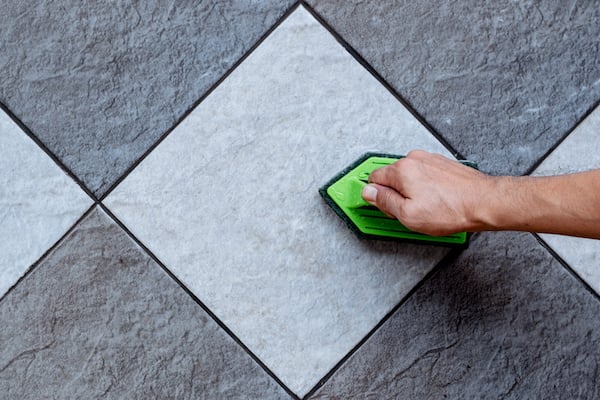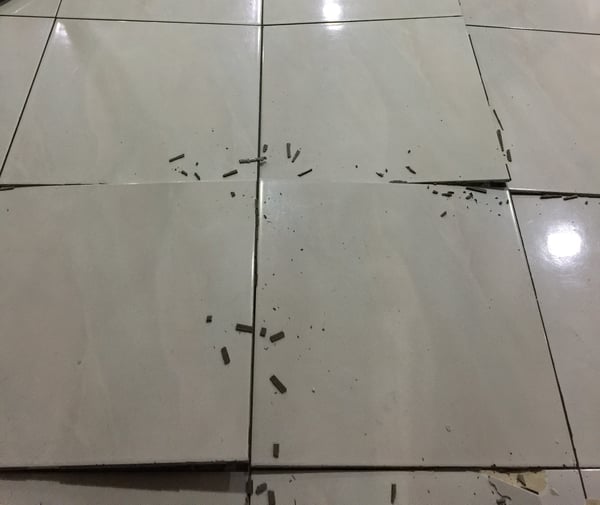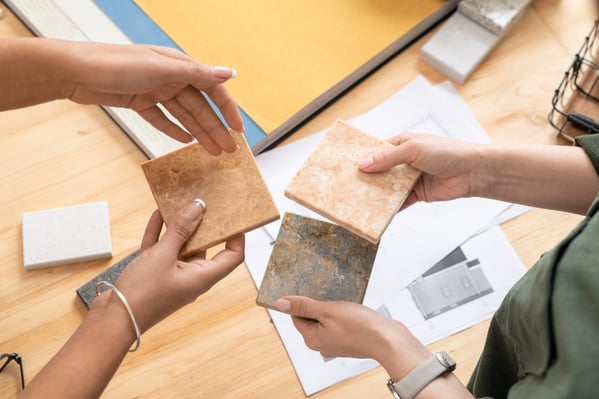Tile surface refinishing is a process where an old, worn-out tile floor is restored to look like new again. It's a great alternative to replacing the entire floor, which can be very expensive.
Old tile floors can start to look worn and dated after years of use. However, if your tile floor is in good condition but wants to give it a fresh new look, you may wonder if it's possible to resurface tile floors.
If your floor tiles look a little worse for wear, you may consider resurfacing them. But can you resurface tile floors? And is it a good idea? Here's what you need to know about floor tile resurfacing:
Can You Resurface Tile Floors?
In short, yes, you can! Resurfacing tile floors is a great way to give them a new lease on life without replacing the tiles entirely. It's also much less expensive than replacing the flooring altogether. However, there are a few things to keep in mind before you decide to resurface your tile floors.
First, not all floor tiles can be resurfaced. Some types of flooring, like natural stone, are too delicate to withstand the resurfacing process.
Second, even if your floor tiles can be resurfaced, it's not always the best option. Resurfacing will remove a thin layer of the tile, so it's possible that the new surface won't match the rest of the flooring perfectly. Loose tile, cracked tile, and tile with a lot of wear and tear may not be good candidates for resurfacing.
Third, you'll need to find a professional flooring resurfacing company to do the job. This is not a project you can DIY.
If you're considering resurfacing your floor tiles, be sure to talk to a professional about whether or not it's the right choice for your home.
How To Resurface Tile Floors
If you've decided that resurfacing your tile floors is the way to go, there are a few things you need to do to prepare.
Cleaning And Tile Floor Repair
First, thoroughly clean the floor and make any necessary repairs (like fixing broken tiles). Tile floor cracks can be repaired with a floor patching compound and tile caulk.
Cracked tile and loose floor tile should be replaced before resurfacing.
Sand It Down
Once the floor is clean and in good condition, you'll need to sand it down to create a smooth surface for the new coating. Be sure to use fine-grit sandpaper so you don't damage the tile.
Porcelain tile is tough to sand, so it's essential to be extra careful if you resurface porcelain tile floors. Individual floor tiles can also be sanded by hand using a floor buffer.
Apply Coating
After the floor is sanded, you can apply the resurfacing coating. There are a few different types of coatings available, so be sure to choose one that's designed for use on tile floors. Follow the manufacturer's instructions carefully to ensure the best results.
Apply Sealant
A newly painted tile floor will be more susceptible to stains and wear, so it's important to seal it.
Once the coating is dry, you can apply a sealant to protect it and make it shine. You're now ready to enjoy your newly resurfaced tile floor!
RECOMMENDATIONS FOR RESTORING YOUR TILE FLOORING
Regarding home renovations, few materials have as much potential for transformation as tile. Whether you're looking to add a bit of color, texture, or sparkle to your home, tile can help you achieve that look without making a significant investment in any other remodeling project.
With the proper preparation and maintenance, your tile floors will last for many years with little cost or effort. But before you commit to installing those new tiles, take some time to learn about the pros and cons of resurfacing your current flooring. Before starting this renovation project, here are five tips for resurfacing your tile floors.
Have A Plan Before You Commit To Any Tile
Before you commit to any tile, know what you're looking for in your new flooring. Ask yourself these questions: Will you need a washable or stain-resistant surface? Will you be installing the flooring in an area with pets? Are there kids in your home? If so, do they need an area to play or walk on this flooring? If you have kids or pets, you'll want to choose a tile with a high-quality finish that is easy to clean, stain resistant, and durable.
Kids' tiles come in various bright and fun colors, which are not only easy to clean but also great for helping keep kids active and healthy.

Consider Repairing Your Current Floor Instead Of Resurfacing It
Before you commit to replacing your floor, take some time to consider a few things.
Ask yourself these questions: Does the floor have structural issues, like buckling or warping? Is it cracked or chipped in any areas? Are there any particularly dirty areas that would benefit from a full cleaning? If your tiles are a little dirty and nothing more, this is an excellent time to consider cleaning them.
You can hire a professional cleaner to restore the tile to its original luster or try a do-it-yourself cleaning solution. If your tile is structurally sound and there are no significant issues with it, you may be able to clean it and then seal it to protect it from future damage.
This is a great option for less-expensive tiles, like ceramic or porcelain, which is not as durable as natural stone or non-porous ceramic tile.
Be Prepared For The Smell And Mess Involved In Tiling
When installing a new tile, you'll likely encounter some things you didn't expect. For example, as the adhesive used to install the tiles dries, you may notice a new and unpleasant smell from your subflooring. This smell is typically temporary but can be strong while it's happening.
You'll also likely encounter a bit of mess during the installation process. This is expected, but you can be prepared to minimize this mess using a few tips. First, ensure you have ample room to work on your floor to avoid accidentally damaging the walls.
Wear gloves to protect your fingers from sharp edges when installing the tile, and ensure you have a clean space to lay out your tiles. Use a dust barrier to help keep your tiles and subfloor clean and debris-free.
Check The Structural Integrity Of Your Current Flooring
Tile is a great flooring option for many homeowners, but it's not for everyone. If you have an older home with less-than-ideal subflooring, you may not be able to install the tile. Inspect your current subflooring before you begin any work.
You can do this by removing a few tiles from the floor. If installing tile over wood subflooring, you may need to replace the subfloor before proceeding.
You can hire a contractor to assess your subflooring, or you can do a little research and check it yourself to ensure you have the right subflooring for tile installation. If you have an older home with weaker subflooring, you may want to consider a stronger material, like concrete.

Re-Evaluate Your Color And Material Choices Before Installation
If you've been considering changing the color of your tile, now is a great time to do so.
While the existing tiled surface is partially removed, take this opportunity to change your color. While you'll likely want to use a color that coordinates with the rest of your home, there are a few things to consider when choosing a new tile color.
First, ensure you have plenty of tiles so you don't run out. You don't want to stop your installation in the middle because you don't have enough tiles.
Second, know what the tiles will look like under different lighting conditions. You may want to take a tile or two home with you to see how it looks next to your furniture, walls, and other décor.
Think About Your Long-Term Plans
Before you get started on your tile installation, you may want to consider your long-term plans for the home. If you intend to sell your home in the next five years, you may want to choose a less-expensive tile finish. You can easily remove the tile when you sell your home and update it with a more expensive tile without significant structural damage.
If you plan to stay in your home for many years and want to make significant updates, you may want to consider a more expensive tile. This way, you can install a durable tile, stain- and scratch-resistant, and easy to clean. This tile can help you protect your floors for years and can be a great investment.
Marble tile is another good option for flooring, but it can be more expensive. If you're interested in marble tile, be sure to do your research and find a reputable contractor to install it.
Determine Why You Want To Resurface
Before beginning your tile installation, you should know why you're doing it in the first place. Do you want to change the color of your tile? Is your tile chipping or wearing away? Do you want to refresh the look of your home?
Whatever your reason is, ensure that it's something that will benefit you and your family. A new flooring option can be a great way to boost curb appeal and resale value, but it can also be a major investment.
Final Words
Outdated or worn tile flooring can make your home look dated and worn. If you're considering tile flooring for your home, this article provides a few tips to help you get started.
Resurfacing your tile floors is a great way to revitalize your home. Before you get started, however, make sure you consider these tips. If you're considering installing new tiles over your existing tile floors, make sure you know what you're getting into. You'll likely have to remove your existing tile, and with that comes some mess and smell. Have any questions? Contact our team of experts at Mastercraft USA! We offer a wide ride range of machines for different projects such as ash vacuums, carpet extractors, flood relief, air blowers, floor machines, and more.
5 comments